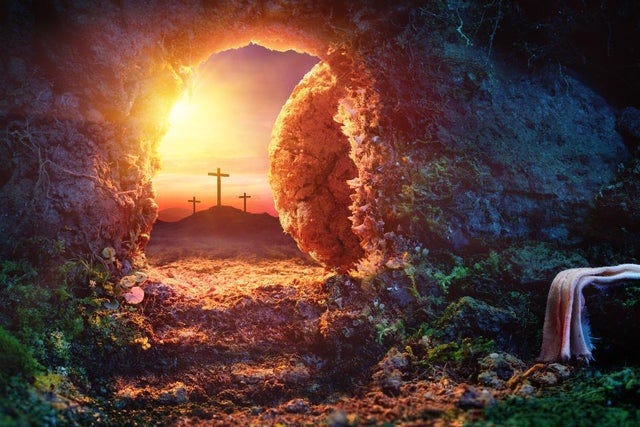A Harmony of the Passion and Resurection of Jesus, #15
Paul's Account, The Ascension, and The Longer Ending of Mark & Notes
PAUL’S ACCOUNT:
For what I received, I passed on to you as of first importance: That Christ died for our sins according to the Scriptures, that he was buried, that he was raised from the dead on the third day according to the Scriptures, and that he appeared to Peter, and then to the twelve.
After that, Jesus appeared to more than five hundred of the brothers at the same time, most of whom are still living, though some have fallen asleep.
Then Jesus appeared to James, then to all the apostles, and last of all, he also appeared to me, as to one abnormally born.
THE ASCENSION:
Luke ends his Gospel this way:
When he had led the disciples out to the vicinity of Bethany, he lifted up his hands and blessed them. While he was blessing them, he left them and was taken up into heaven. Then they worshiped him and returned to Jerusalem with great joy. And they stayed continually at the temple, praising God.
Luke begins Acts this way:
In my former book, Theophilus, I wrote about all that Jesus began to do and to teach, until the day he was taken up to heaven, after giving instructions through the Holy Spirit, to the apostles he had chosen.
After his suffering, Jesus showed himself to these men, and gave many convincing proofs that he was alive. He appeared to them over a period of forty days and spoke about the kingdom of God.
On one occasion, while Jesus was eating with them, he gave them this command: “Do not leave Jerusalem, but wait for the gift my Father promised, which you have heard me speak about. For John baptized with water, but in a few days you will be baptized with the Holy Spirit.”
Therefore, when they met together, the disciples asked him, “Lord, are you at this time going to restore the kingdom to Israel?”
Jesus said to them, “It is not for you to know the times or dates the Father has set by his own authority. But you will receive power when the Holy Spirit comes on you. You will be my witnesses in Jerusalem, and in all Judea and Samaria, and to the ends of the earth.”
After Jesus said this, he was taken up before their very eyes, and a cloud hid him from their sight. They were looking intently up into the sky as he was going, when suddenly two men dressed in white stood beside them. They said, “Men of Galilee, why do you stand here looking into the sky? This same Jesus, who has been taken from you into heaven, will come back in the same way you have seen him go into heaven.”
THE LONGER ENDING OF MARK:
When Jesus rose early on the first day of the week, he appeared first to Mary Magdalene, out of whom he had driven seven demons.
She went and told those who had been with him and who were mourning and weeping. When they heard that Jesus was alive and that she had seen him, they did not believe it.
Afterwards, Jesus appeared in a different form to two of them while they were walking in the country. These returned and reported it to the rest, but they did not believe them either.
Later, Jesus appeared to the eleven as they were eating. He rebuked them for their lack of faith and their stubborn refusal to believe those who had seen him after he had risen.
Jesus said to them, “Go into all the world and preach the good news to all creation. Whoever believes and is baptized will be saved, but whoever does not believe will be condemned.”
“And these signs will accompany those who believe: In my name they will drive out demons; they will speak in new tongues; they will pick up snakes with their hands; and when they drink deadly poison, it will not hurt them at all; they will place their hands on sick people, and they will get well.”
After the Lord Jesus had spoken to them, he was taken up into heaven and he sat at the right hand of God.
Then the disciples went out and preached everywhere, and the Lord worked with them and confirmed his word by the signs that accompanied it.
NOTE ON PAUL’S ACCOUNT:
Paul’s account of the resurrection appearances of Jesus adds several more unique points to the story of Easter and afterwards. Paul speaks of how he delivered to the church at Corinth what he had received from the apostolic witnesses. Paul tells us the heart of the gospel: Christ died for our sins, he was buried (a confirmation that he had truly died), and he was raised from the dead on the third day – all “according to the Scriptures” (which means, in fulfillment of the Old Testament prophecies).
Notice how Paul uses the phrase “on the third day” repeatedly. The Jewish people counted parts of a day as a whole day. Therefore, the three days would include a part of Friday afternoon, all of Saturday, and part of Sunday morning. (Remember that sundown begins a new day.)
Paul mentions how Christ appeared to Peter. Luke will mention this only in passing, when the disciples tell the excited travelers to Emmaus that Jesus appeared to the women and Peter on Sunday.
Even though Paul mentions “the twelve,” this is probably the Sunday evening appearance to the ten disciples, Thomas being absent. (The term, “the twelve” is a standard way of referring to the original group of apostles Jesus called.)
The appearance to over 500 people may be the ascension of Christ from the Mount of Olives. But perhaps not. Paul points out that some of these people are still alive, and the Corinthians could verify this fact with them, if they want to pursue the matter further. (Paul is listing all of these appearances to bolster the faith of the people in Corinth who had some considerable doubts about the resurrection of Jesus.)
Paul also tells us about how Jesus appeared to his half-brother James. (This is not James, the son of Zebedee.) It is not clear when this exactly happened.
James, along with the rest of his brothers did not believe in Jesus before Easter. However, he afterward joined the apostolic band, and was present with them on the Day of Pentecost (along with the rest of his brothers) and later became a prominent leader in the Jerusalem church. James is the author of the Letter of James, a book that echoes many of the themes of the Sermon on the Mount. Jude, another half-brother of Jesus, wrote the Letter of Jude.
Paul says, “Last of all, he appeared to me.” Here is a reference to the famous Damascus road experience of Paul, something that changed his life forever. The risen Lord appeared to Paul.
In the same way, the events of Easter changed all of the disciples in a profound way. Before this, they were fearful, unstable and unreliable. After Jesus rose from dead, and after the Day of Pentecost, the disciples become bold and faithful witnesses to what they saw. They were still sinners, but they had experienced God’s power and grace through the Messiah of Israel.
Their story has now been passed on to us. Paul says, “For what I received, I passed on to you as of first importance: that Christ died for sins, was buried and that he was raised on the third day.” This is the same gospel, that we have received from the apostles, and by this gospel we are saved.
NOTE ON THE LONGER ENDING OF MARK:
This Longer Ending of Mark is not found in the oldest and best Greek manuscripts we have today. It is found in later copies of Mark, and the King James Bible translators used these later copies for their work. (These were the only ones available to them at the time.)
This ending was probably written by someone else, perhaps by another apostle. These words display certain peculiarities of grammar, style, vocabulary, and theological content that are unlike the rest of Mark’s Gospel. The ending has clear allusions to John, Luke and the Book of Acts (especially speaking in tongues and Paul being bitten by a poisonous snake).
Mark probably ended his Gospel abruptly with the words, “They said nothing to anyone, because they were afraid.” The women at the tomb are fearful and confused by the angels’ message. “Trembling and bewildered, the women went out and fled from the tomb. They said nothing to anyone, because they were afraid.” Mark just stops there. “Afraid” is his last word to us.
You can see why someone might try to add “a better ending” to try to finish the story, and not end on such a negative note. However, I think that was exactly Mark’s intent. He ends his gospel so abruptly on purpose.
Mark is telling us that we each have to overcome our fears and finish the story of Easter by telling others the good news that Christ has risen from the dead. We have to go and tell the good news to everyone! We can’t just “say nothing to anyone” because we are afraid of what they may think of us.
The women did overcome their fear, and we need to do the same. We also need to boldly confess that the tomb is empty. We need to tell everyone that Christ has risen.
In any case, the Longer Ending of Mark was well known to the early church, and it contains a nice summary of what happened after Jesus rose from the dead and ascended into heaven. There is no harm done if you want to include it with Mark’s Gospel. But just be aware that Mark probably didn’t write it.
We will be on break for a week. We hope you enjoyed the Harmony. Have a blessed Easter!






